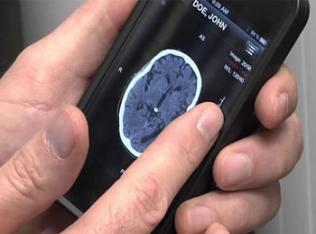Distant site
A site where a health care provider who provides telemedicine services is located or based while providing these services via a telecommunications system.
E-consult
Providers use technology (often store and forward) to collaborate and share information with other providers around the care of a patient. Examples could include a primary care physician requesting input and review of a patient case by specialists, or a patient requesting a second opinion for a complex case.
E-visit
This is a broad term but often refers to secure email or web-based chat exchanges between a patient and his or her provider team, usually for limited conditions.
Home monitoring or Remote Patient Monitoring (RPM)
These terms refer to programs that allow data collection of health and medical data from an individual in one location and transmitted electronically to a health care provider team in a different location for use in patient care. Home telemonitoring is a rapidly growing component of health care and telemedicine, enabling patients to easily provide information to a care team from the comfort of home.
In the case of cardiac care patients, for example, patients are provided with technology that they then use at home every morning to check their blood pressure, pulse, oxygen levels, and weight. They then answer symptom questions on a touch-screen computer, and data is sent to their care team. A nurse reviews the data and appropriate intervention is taken when readings are outside established parameters. This allows the involvement of specialist physicians-at the right time, allowing the patient to stay at home whenever possible. Millions of patients worldwide use telemedicine to monitor their vital signs, helping them to remain healthy and out of hospitals and emergency rooms.
Hub and spoke
The hub and spoke telemedicine model connects several smaller spoke hospitals to one or more hub hospitals via formal agreements to engage in telemedicine consultation. Hub hospitals are typically academic medical centers, with specialty and subspecialty expertise available 24 hours a day, 7 days a week. Spoke hospitals are typically smaller and do not have extensive specialty support. They may be community hospitals located in underserved rural or suburban areas.
mHealth/m-health
mHealth, short for mobile health, is another form of telemedicine. Patients and physicians use mobile devices (mobile phones, tablets) in the practice of medicine. m-health can include biomonitors and applications (apps). A globally exploding industry, global health and public health, this platform has demonstrated its value in developing countries and public health efforts and continues to reveal important implications for the future of health care everywhere!
Originating site
A site where a patient is located at the time telemedicine health care services are provided or a consult originates. A facility fee is often paid to the originating site when 'hosting' a telemedicine service.
Peripheral devices (telemedicine)
These are instruments that can be attached to a practitioner's cart (or connected through wired or wireless means to laptops/tablets/smartphones) that can assist in an interactive or collaborative examination. Examples include stethoscopes, otoscopes, ophthalmoscopes, ultrasound, cameras, etc.
Practitioner's cart (telemedicine)
This is a mobile cart designed for a clinic or hospital health care setting that includes a monitor and camera, often with the addition of a computer workstation and peripheral devices.
Store and Forward
This term refers to the use of technology for electronic sending of information—images, videos or medical records—for asynchronous review and consultation by a specialty provider. This can allow timely consultation and collaboration in a cost-effective way. Teleradiology and teledermatology are important examples of this capability.
Telemedicine clinic
By placing sophisticated equipment in clinic spaces in a patient’s local community, (primary care clinics, nursing homes, etc.) an appointment can be scheduled with a specialist at a distance. Patient and physician can see and hear each other during the synchronous consultation, and in cooperation with medical staff on-site, appropriate examination is performed.
Telepresenter
A trusted collaborator who assists in a clinical telemedicine encounter, on the patient side, by assisting with aspects of the physical examination by the remote specialist. This new and evolving role can be served by a variety of tech, medical assistant, nurse, mid-level provider, or physician, depending on the circumstances and consultation being provided.
Virtual visit
Virtual visits use secure web videoconferencing technology to offer patients the opportunity to receive personalized, convenient care from their home, workplace or any private location-on their own familiar devices (computer, tablet, smartphone)- in a way that is efficient, and convenient, and suited to the patient's needs.
